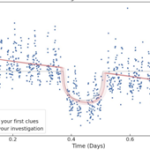
Project Gallery 2023
Secondary students from across Europe became exoplanet detectives with ESA and used Cheops satellite data to uncover the mysteries of two exoplanet targets: KELT-3b and TOI-560c.
Explore the projects below.
Yarkopsky
Colegio Abraham Maslow Chía – Cundinamarca Colombia 15 years old, 17 years old 6 / 3
TOI-560c
TOI-560c project description:
In this project, it has been analysed multiple data given by the European Space Agency with CHEOPS (Characterising Exoplanets Satellite) satellite whose objective is to stablish theories in a more precise way about the planetary formation and chemical composition of planets. Acording to this Data, it was found the transit depth, radius of the planet radius of the star, distance, density, and habitability of the exoplanet TOI-560 c
TOI-560c Results and Analysis
The first characteristic of the exoplanet that was calculated was the depth of transit which was 0.1130601861%. Then it was calculated the distance between the star and the planet, it was needed the planet radio and the star radio that ended up being 0.653 Rs or 454292.1 Km and 2.395 Rt o 15275.31 km respectively according to the adjust of the graph (Figure 1), the resulting distance was 2.7×10^10 m. As third it was needed to determine the habitability according to the temperature, the planet that was around 225 almost the point in which tin melts, that became it inhabitable. At last, it was calculated the density of the exoplanet, but first it was needed to figure out the volume that was 1.49×10^12 mk^3 and that lead to calculate the density that was 3.88×10^12 kg/m^3 or 3.88 g/cm^3.
The radius of the exoplanet is similar to the one of the planet Neptune as it has 3.88 Rearth which is closest to the radius of the exoplanet. Taking into account the mass of the exoplanet which is 9.70 times the mass of the earth, the closest planet is Uranus with 14.5 times the mass of the earth. With the mean orbital distance and orbital period, the closest planet to the exoplanet is Mercury, although the results are not very similar, since the mean orbital distance is 0.39 and the orbital period is 88, which has no similarity with TOI-560C. Finally, the density of the exoplanet is almost similar to the one of Mars with a difference of 0.5 and the average temperature is similar to that of Mercury with a difference of 58 °C.
TOI-560c Conclusions
The exoplanet TOI -560 C is located in the uninhabitable zone of planets, since it has a high temperature, it is a place that cannot sustain life, due to the high temperatures that makes impossible to have liquid water on the surface, which is an important requisite for life as we know it.
Respect to its composition it could be said that is rocky planet, due it’s high density and that has a similar size to Neptune. However, despite the fact that this exoplanet is called Mini-Neptune in this project we can proof that is false because ignoring the fact that its size is similar to Neptune, it could not be found more characteristics that could relate this exoplanet with Neptune. Also, it could be said that the error of the radio of the planet was 29.5% from the radio calculated in this project and the real radio of the exoplanet.
Supporting files:



